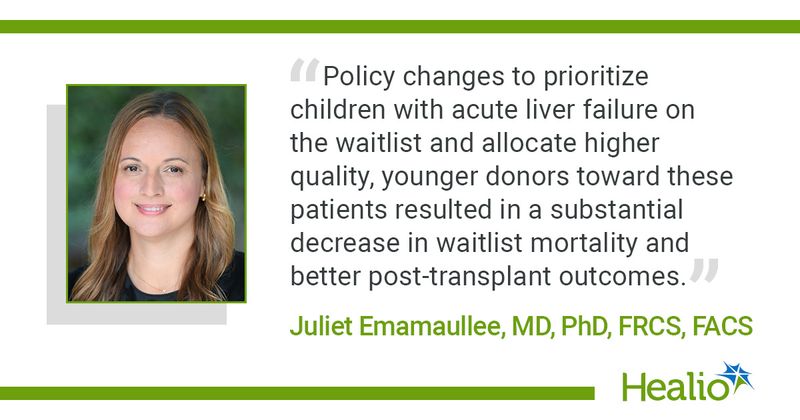Waitlist priority, quality donors tied to better outcomes in pediatric acute liver failure
Key takeaways:
- From January 1989 to December 2020, liver transplantation increased from 71.8% to 86.6%.
- Waitlist deterioration or mortality decreased from 19.2% to 7.2% during this time.
Over three decades, changes to organ allocation policies were associated with reduced waitlist mortality and increased rates of liver transplant among children with pediatric acute liver failure, according to research in JAMA Surgery.
“Pediatric acute liver failure is a rapidly progressive disease that occurs in otherwise healthy children,” Juliet Emamaullee, MD, PhD, FRCS, FACS, study author and research director in the division of abdominal organ transplantation at Children’s Hospital Los Angeles, told Healio. “Up to 25% will require emergency liver transplant. How quickly these patients are placed on the waiting list and receive a suitable offer can impact their ability to be stable enough for transplant.”

She continued: “For this study, we wanted to understand how policy changes had impacted waitlist mortality, waiting time and post-transplant outcomes for children with acute liver failure who need a liver transplant.”
Using the Scientific Registry of Transplant Recipients, Emamaullee and colleagues identified 1,495 children (median age at listing, 6 years; 54.6% boys) with acute liver failure on the LT waitlist between January 1989 and December 2020, who were grouped by Status 1/1A listing date. The researchers also evaluated Organ Procurement and Transplantation Network policies related to liver transplant during this time.
Overall, 29.6% of patients were waitlisted between January 1989 and June 15, 2000 (era 1), 43.4% between June 16, 2000, and Feb. 1, 2012 (era 2) and 27% between Feb. 2, 2012, and December 2020 (era 3).
According to results, LT rate increased from era 1 to era 3 (71.8% to 86.6%), while waitlist deterioration or mortality dropped during this time (19.2% to 7.2%).
Although the median distance between donor and recipient hospitals increased from era 1 to 3 (182.9 km; 95% CI, 16.5-643 vs. 515.7 km; 95% CI, 108.6-1,297.8), children in era 3 were more likely to receive a whole liver (56.8% vs. 72.3%), with a shorter median cold ischemic time (8.3 hours; 95% CI, 5.4-10.8 vs. 6.5 hours; 95% CI, 5.3-8.2). Era 3 also had the highest rate of post-transplant patient and graft survival at 5 years.
In addition, donors in era 3 were younger (median age, 14 years), smaller in size (median height, 152 cm; median weight, 50 kg) and “more likely to be deceased” (95%).
“Policy changes to prioritize children with acute liver failure on the waitlist and allocate higher quality, younger donors toward these patients resulted in a substantial decrease in waitlist mortality and better post-transplant outcomes,” Emamaullee said. “This could be attributed to shorter waiting time and receipt of organs from younger, smaller organ donors over a larger geographic region.”
Further, multivariate analysis showed that risk for mortality after transplant in era 1 was associated with age younger than 2 years (subdistribution HR [sHR] = 8.88; 95% CI, 2.11-36.49), Hispanic ethnicity (sHR = 0.08; 95% CI, 0.02-0.39) and receipt of deceased donor split grafts (sHR = 0.17; 95% CI 0.05-0.58), all of which resolved by era 3. Younger recipient age also was associated with risk for graft failure in eras 1 and 2 (sHR = 4.89; 95% CI, 1.56-15.3), which resolved by era 3.
“These results confirm that continuous evaluation and revision of policies regulating organ allocation and waitlist prioritization for disadvantaged populations like children can result in meaningful improvements in their survival,” Emamaullee told Healio.
